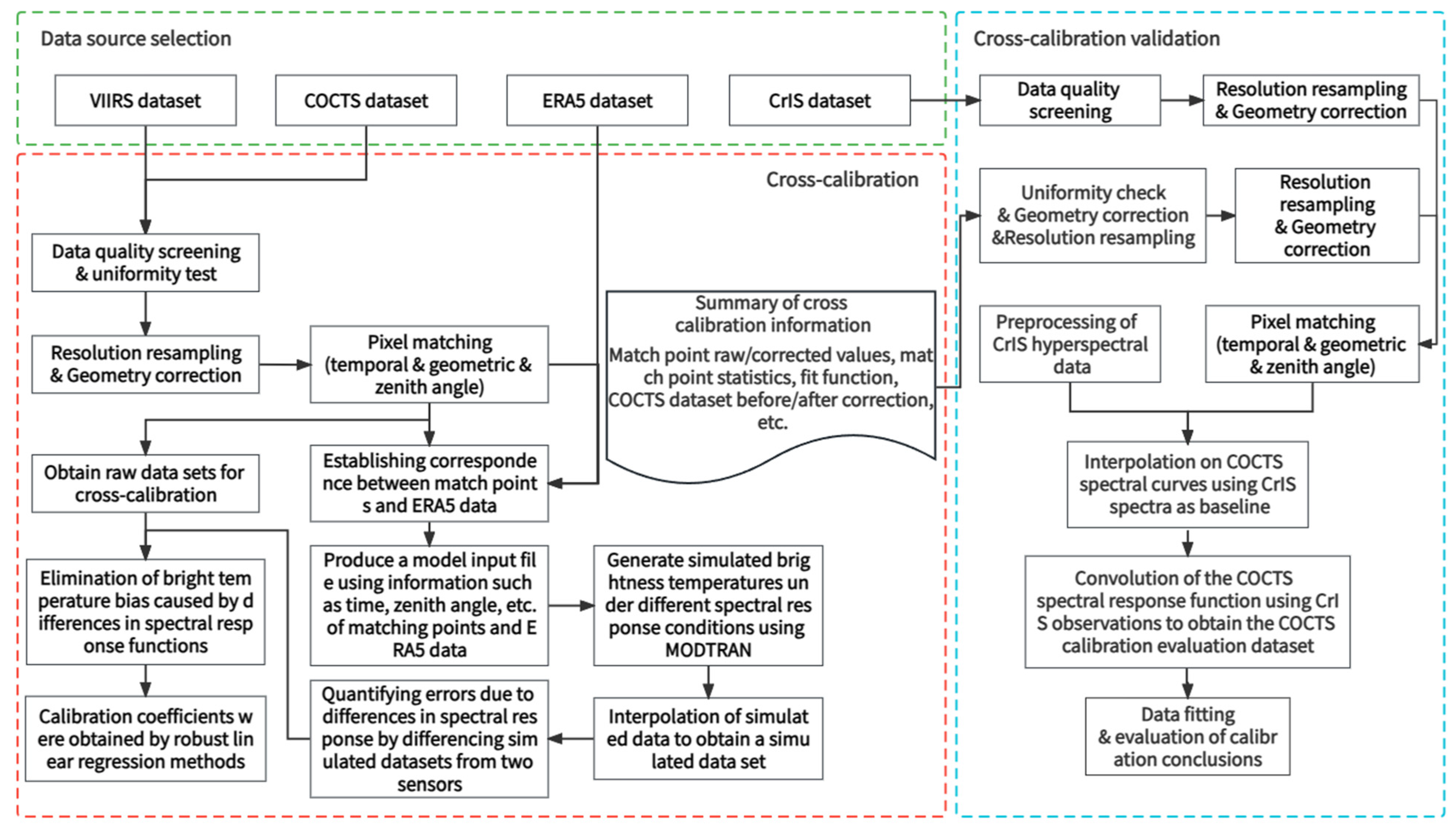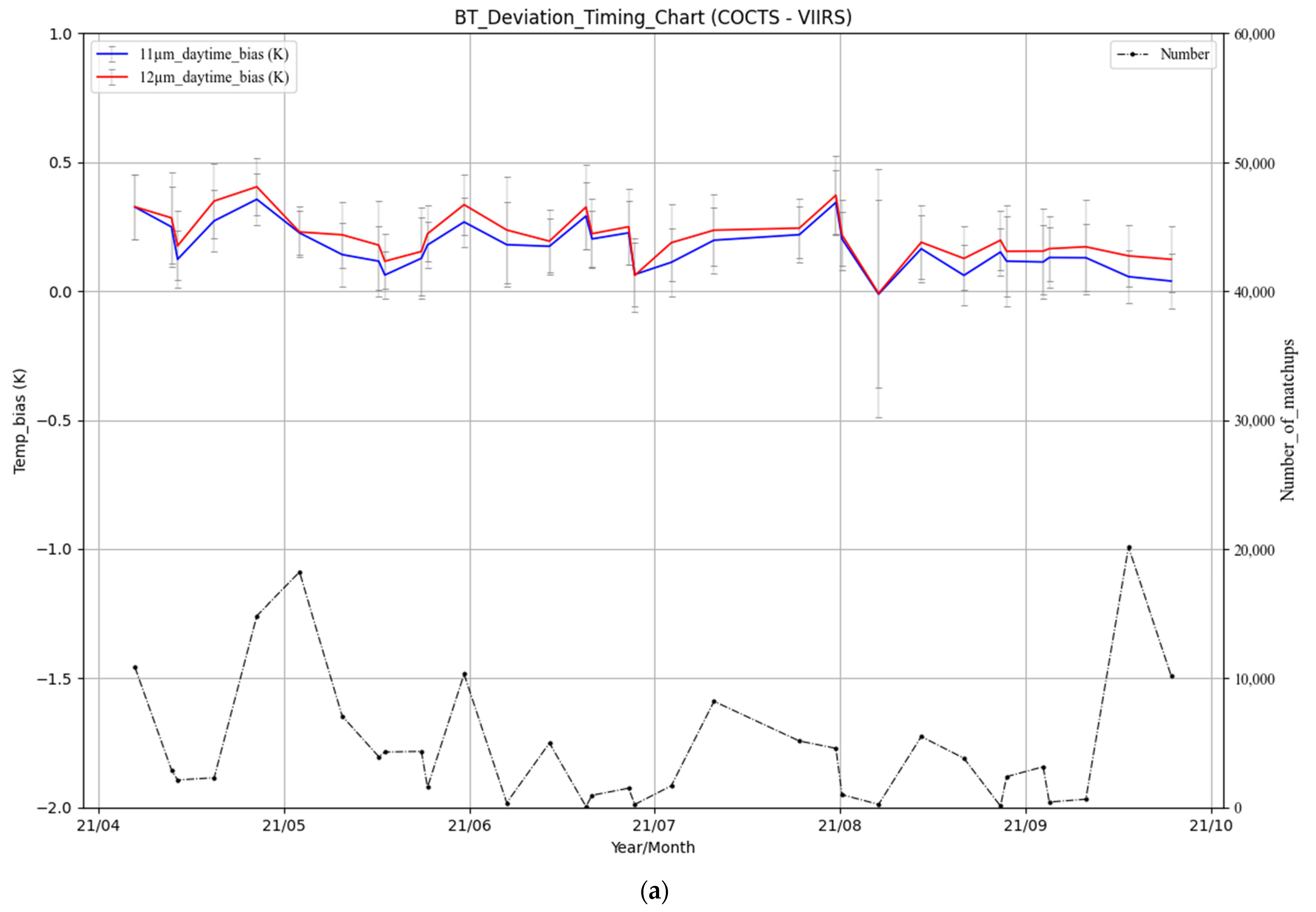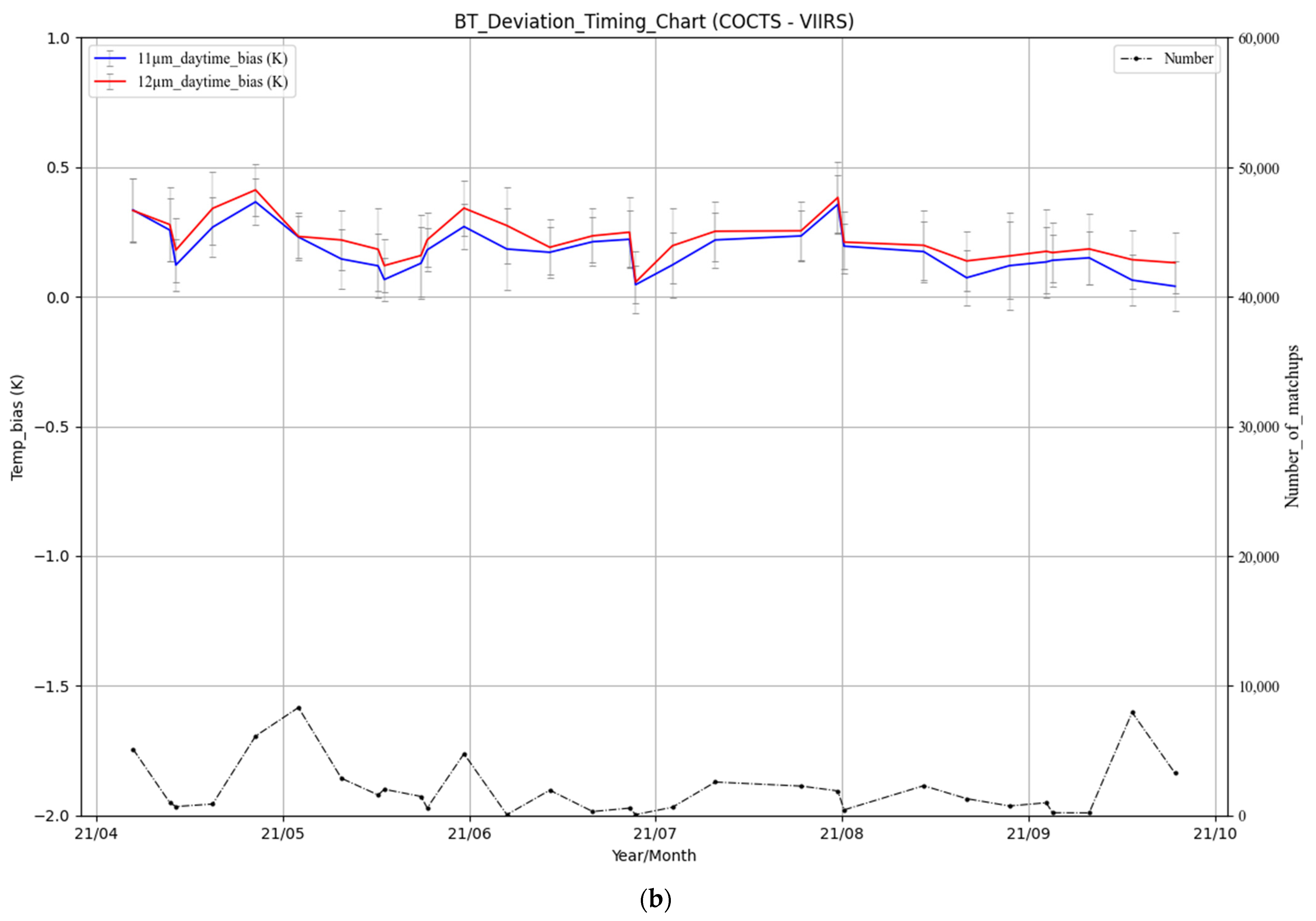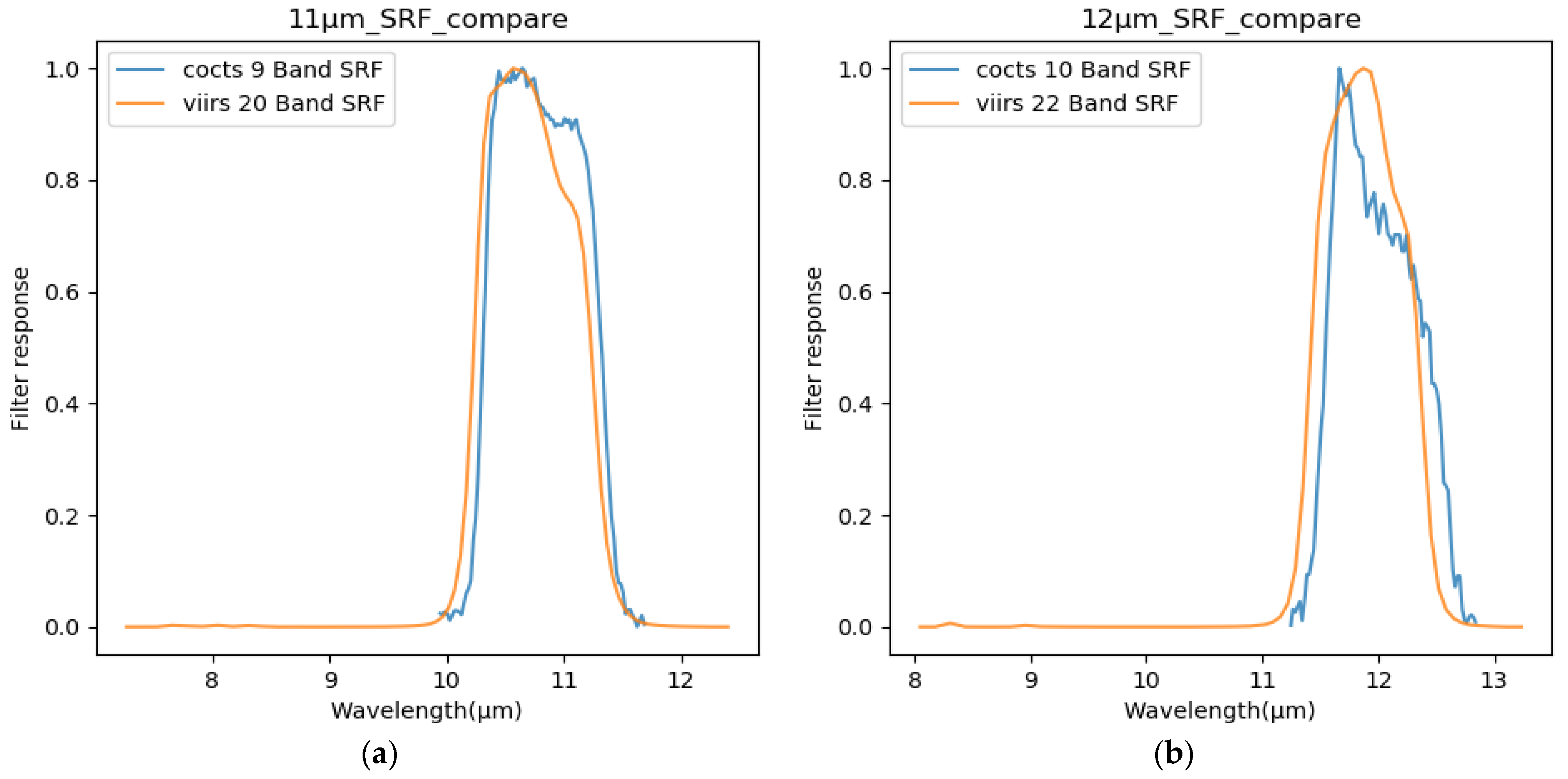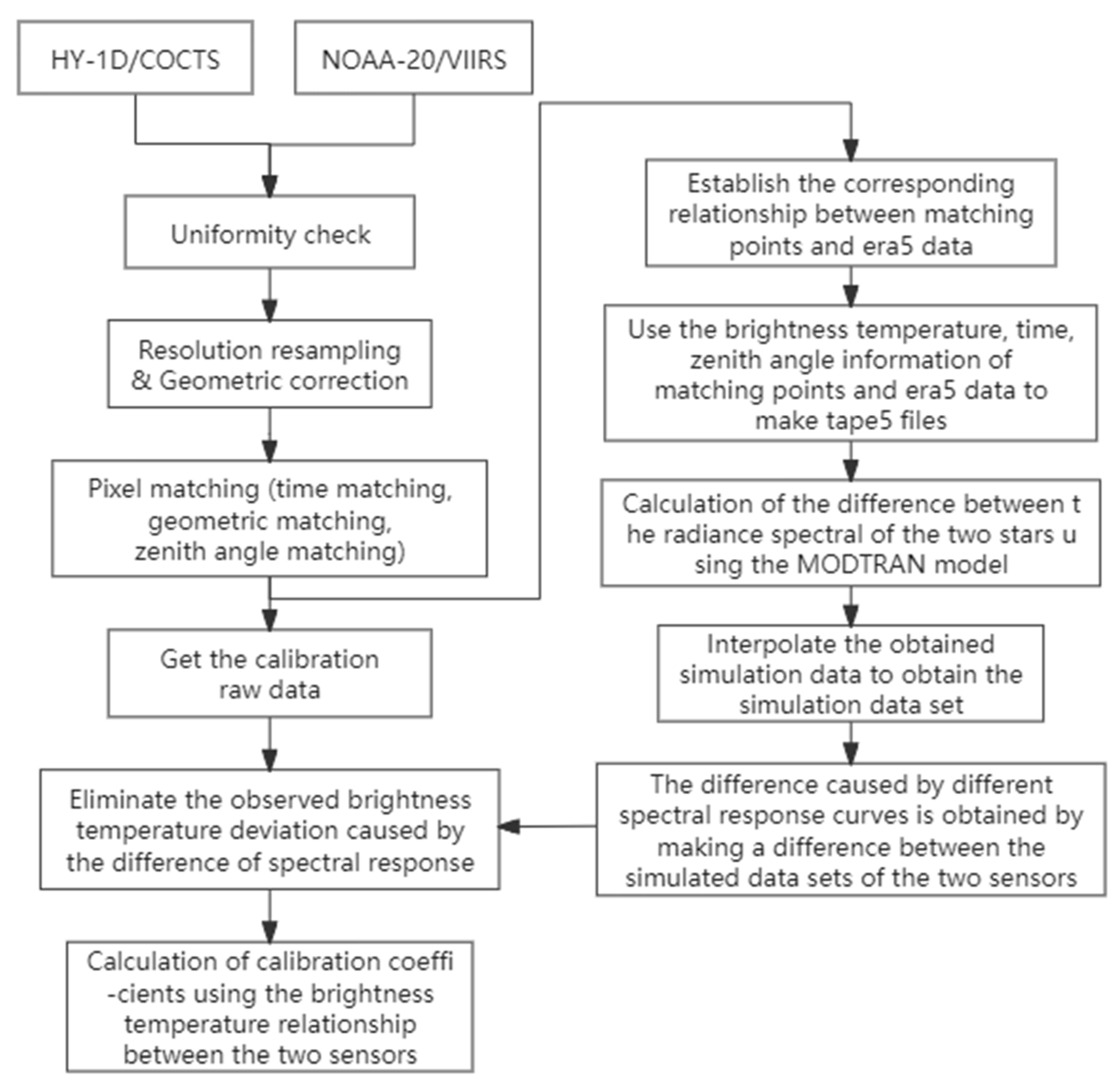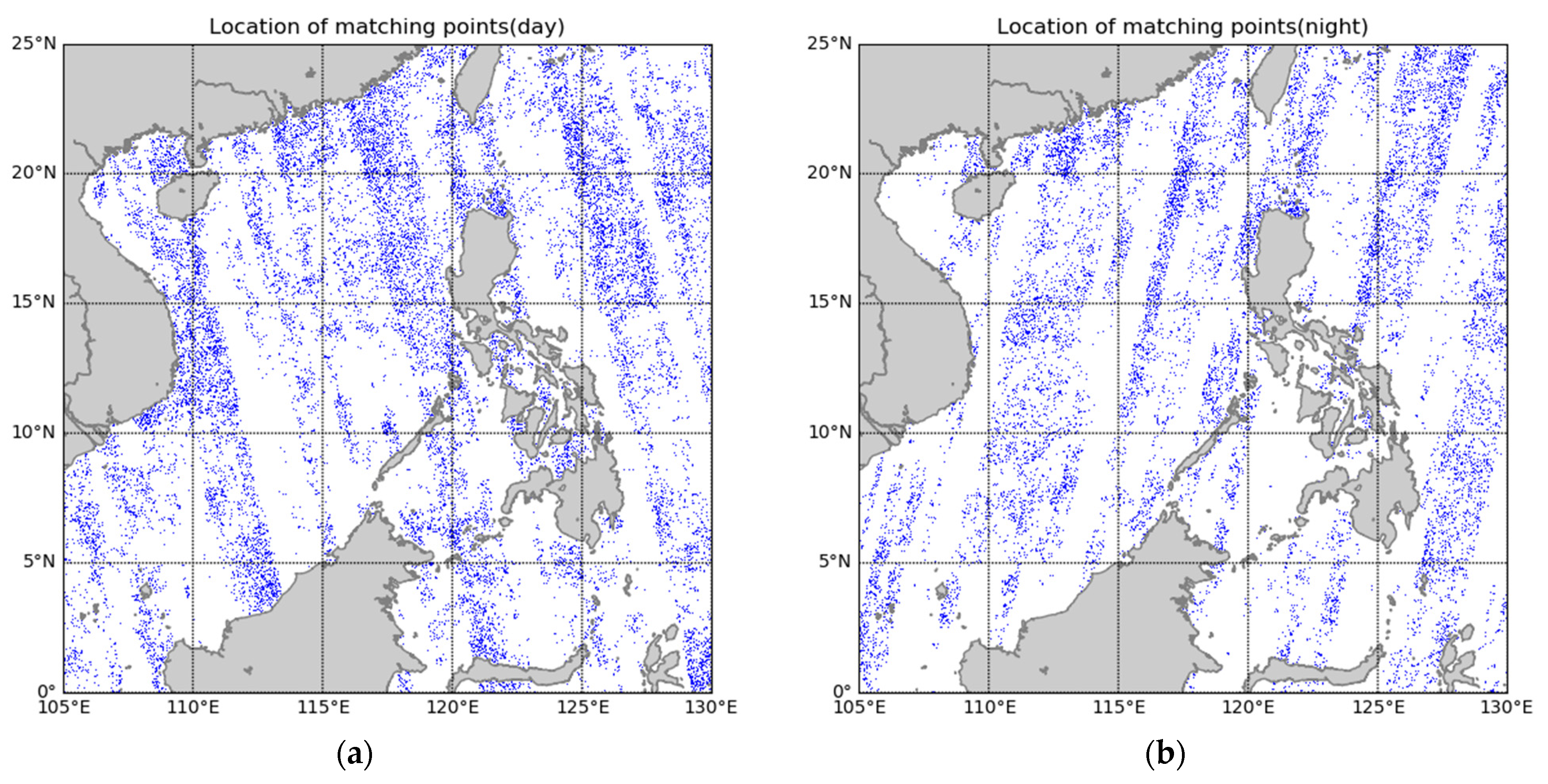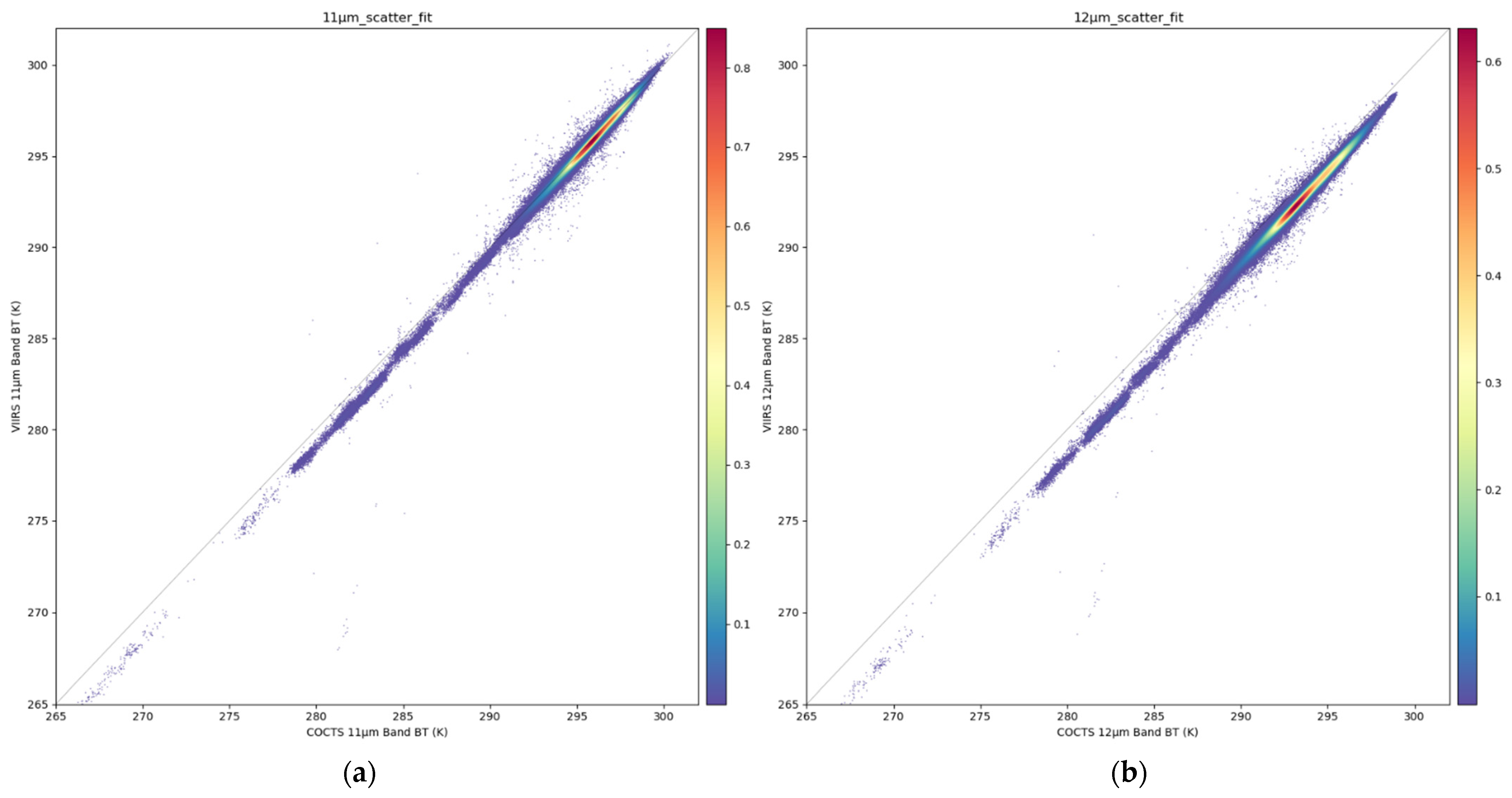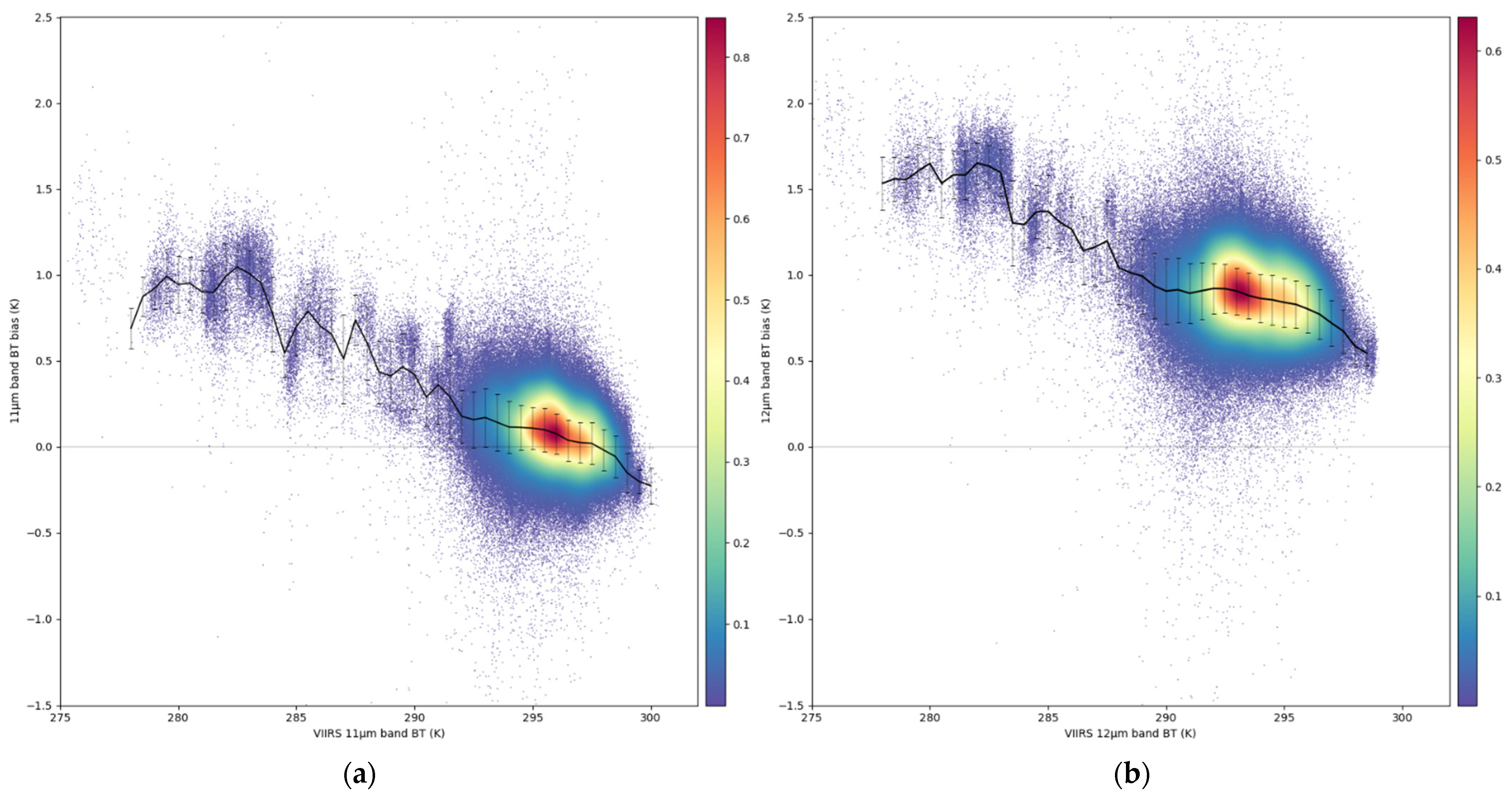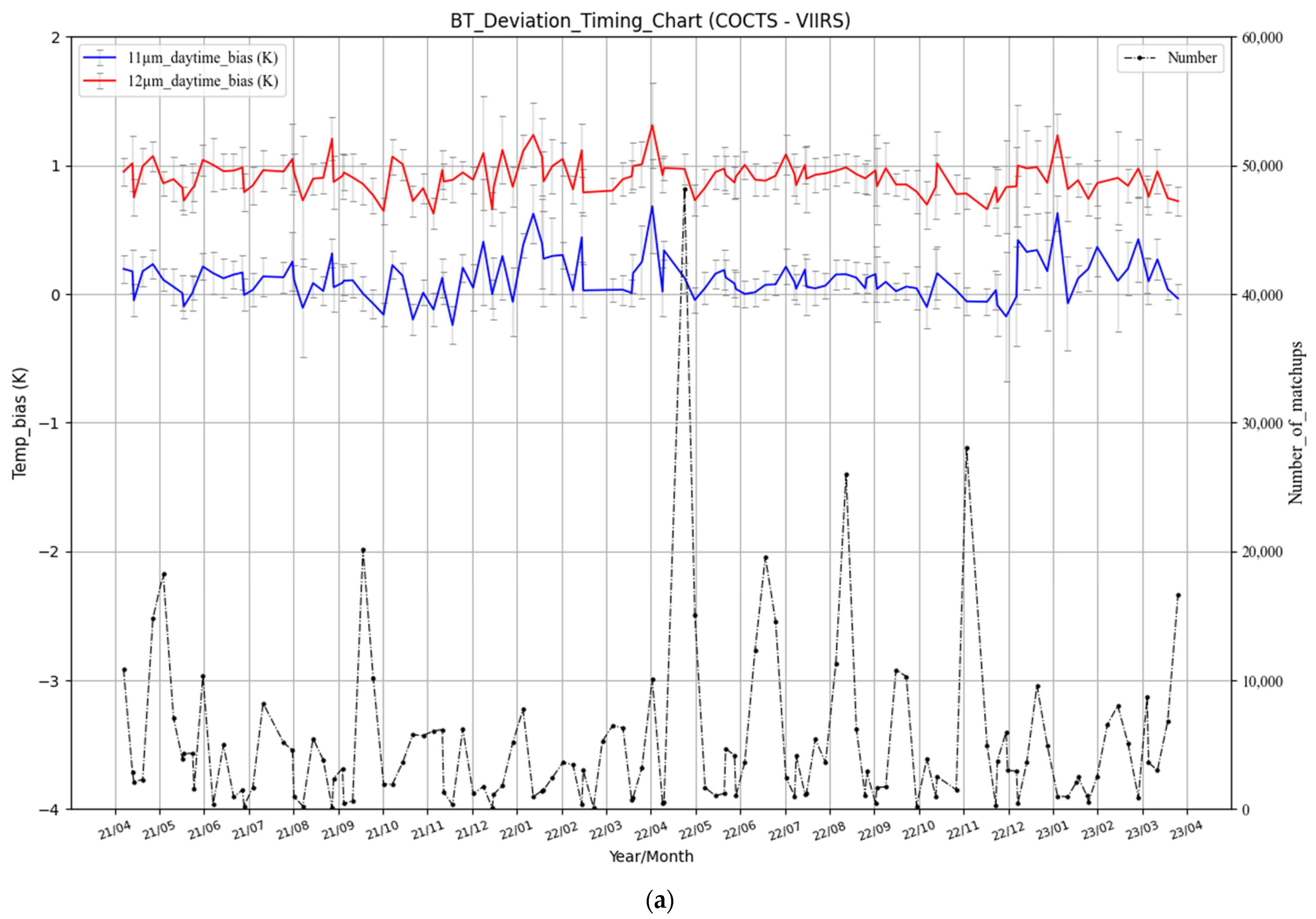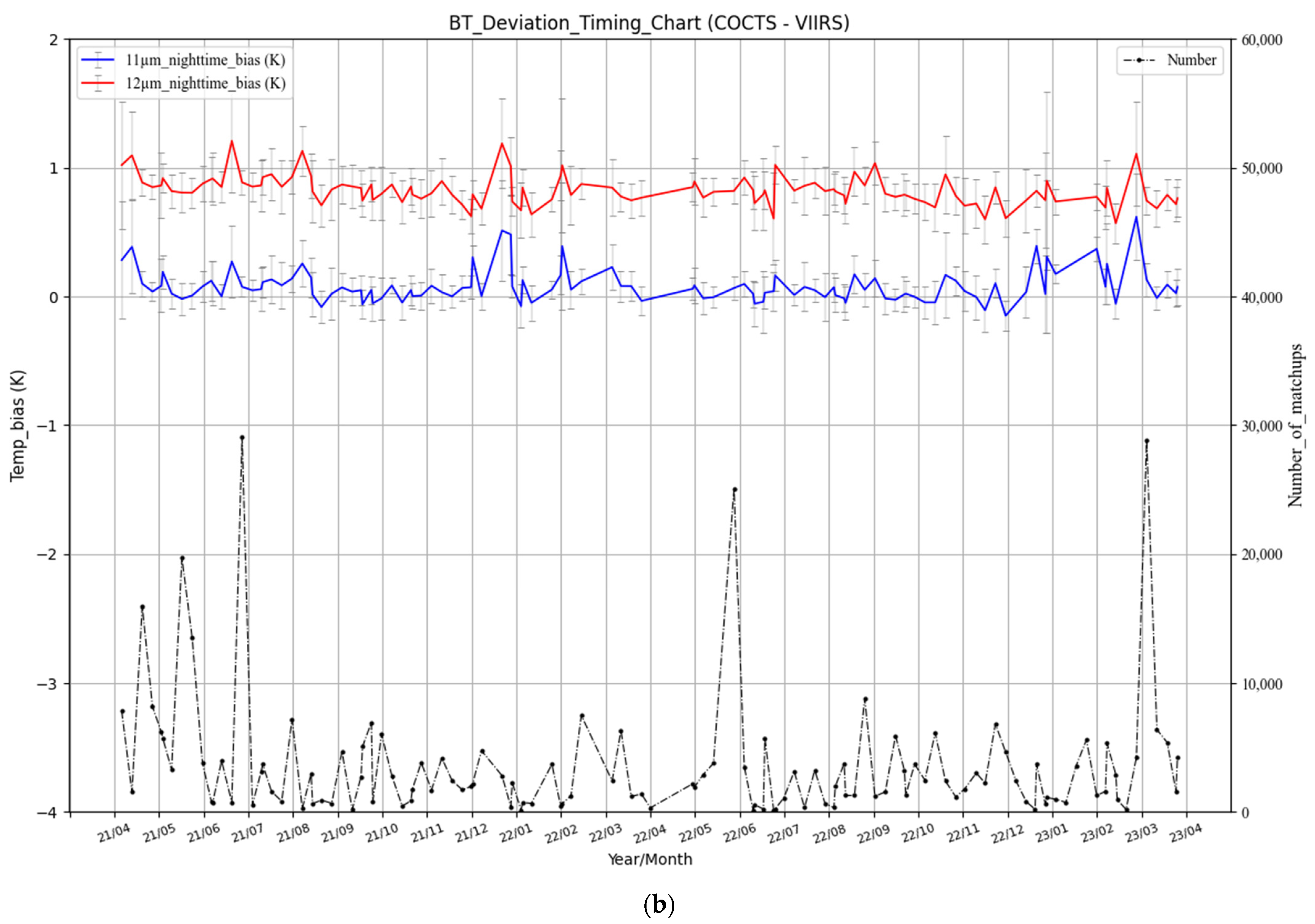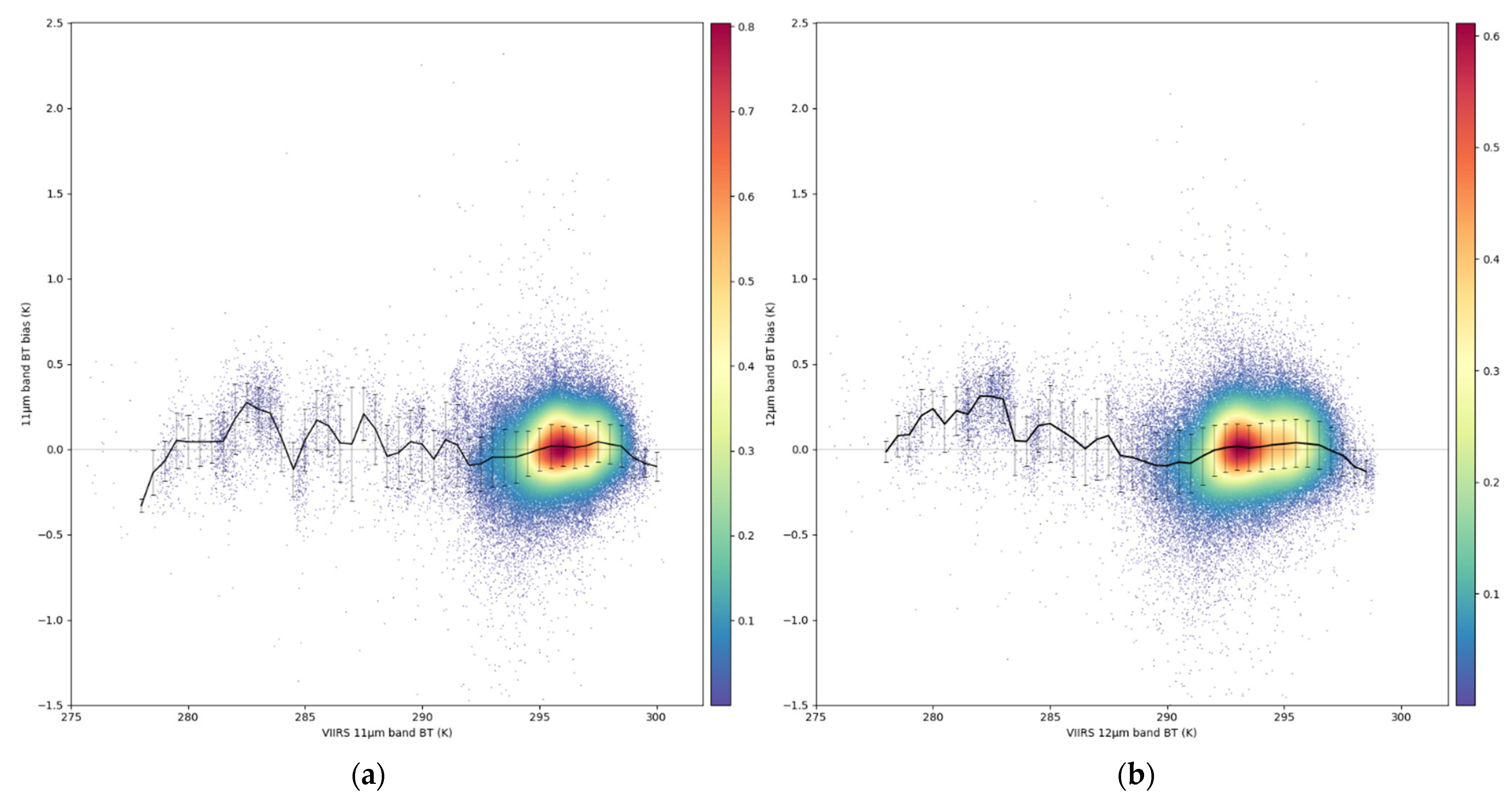1. Introduction
The second operational satellite in the Haiyang-1 series, Haiyang-1D (HY-1D), was launched on 11 June 2020. The satellite is positioned at a nominal orbital altitude of 782 km [
1] and one of the payloads is the Chinese Ocean Color and Temperature Scanner (COCTS), which detects ocean color and sea surface temperature (SST). It has a swath width of 3000 km and the ability to achieve global data coverage in a single day. HY-1D/COCTS forms a network with the same series of satellites, Haiyang-1C (HY-1C), for both morning and afternoon transit observations [
2].
The South China Sea, with its unique geographical location, is rich in marine thermodynamic processes, and its thermal conditions and changes are very complex, with the strongest convection, high water vapor content, and extremely strong sea–air interactions. The South China Sea is also an important region where the East Asian monsoon system interconnects and interacts with the South Asian monsoon and the Asian–Australian monsoon systems, and as a conduit for water vapor transport from various air streams to the Chinese mainland in summer, the thermal effect of the South China Sea and the related processes of sea–air interactions have an important impact on the weather and climate of the Chinese mainland [
3]. Therefore, understanding the spatial and temporal distribution of the SST field and its long-term trend in the South China Sea is of great significance to marine scientific research and meteorological and weather prediction, and the relevant research and predictions need to be supported by high-quality satellite SST data. To enable the HY-1D/COCTS thermal emissive bands to accurately observe the ocean thermal conditions in the South China Sea region, this paper takes the South China Sea as a calibration scene and carries out a calibration study on the thermal emissive band observations of HY-1D/COCTS.
Radiometric calibration is a prerequisite for ensuring the quality of satellite observation and the derived products. Radiometric calibration of the thermal emissive bands of HY-1D/COCTS will effectively improve the accuracy of COCTS in thermal emissive bands, thus ensuring that the remote sensing data can accurately reflect the real field. Cross-calibration is an efficient radiometric calibration method for calibration by establishing the corresponding observation conversion relationship between the sensors to be calibrated and the reference sensors with good calibration accuracy [
4,
5]. Compared to other calibration methods, cross-calibration is more adaptable to calibration scenarios, requires fewer resources, and can provide a large number of simultaneous observations to support the calibration process and to observe and verify calibration results [
6]. Mittaz et al. conducted a cross-calibration study of the thermal emissive bands of the Advanced Very-High-Resolution Radiometer (AVHRR), based on the Infrared Atmospheric Sounding Interferometer (IASI) data [
7], which reduces the bias of the AVHRR observations. Efremova et al. compared and analyzed the observed differences in the thermal emissive bands of the Visible Infrared Imaging Radiometer Suite (VIIRS) on board the S-NPP satellite and the Moderate Resolution Imaging Spectroradiometer (MODIS) on board the Aqua satellite using the cross-calibration method [
8]; the results show that there is a small negative bias in the VIIRS sensor observations relative to MODIS. Ye et al. calibrated the thermal emissive bands of the visible and infrared multispectral sensor (VIMS) on board the Gaofen-5 satellite with Aqua/MODIS as the reference sensor [
9]. Rong et al. carried out simultaneous measurements and calibrations of Fengyun-2B and Fengyun-2C satellite infrared bands in the South China Sea, respectively, and the two experiments obtained good results [
10], which also provided a scientific basis for the study of calibration in the South China Sea.
In this paper, we focus on the evaluation and cross-calibration of regional HY-1D/COCTS thermal infrared observations in the South China Sea. Cross-calibration of the HY-1D/COCTS thermal emissive bands requires the selection of a sensor with both similar characteristics and reliable observation accuracy as a reference. Launched in November 2017, the NOAA-20 satellite operates in a polar sun-synchronous orbit at a nominal altitude of 824 km, with a swath width of 3060 km, and has a similar afternoon equator crossing time to HY-1D [
11]. The central wavelengths of the thermal emissive bands of the VIIRS on board NOAA-20 are 10.7 μm and 12.0 μm, respectively. The daily bias of the observed BTs of the thermal emissive bands of NOAA-20/VIIRS at the nadir, as well as the observed BTs of the Cross-track Infrared Sounder (CrIS) on board the NOAA-20, is within 0.1 K [
12], and the two thermal infrared bands of the VIIRS offer high accuracy and reliable stability [
13]. Compared with the S-NPP/VIIRS, the thermal emissive bands of NOAA-20/VIIRS have a lower noise equivalent temperature, and their accuracy does not vary with seasons, which provides better stability, and thus NOAA-20/VIIRS is selected as the calibration reference sensor for the HY-1D/COCTS thermal emissive bands.
After cross-calibration of the HY-1D/COCTS thermal emissive bands, a reliable third-party data source is required to validate the COCTS calibration results in order to verify the accuracy of the calibration conclusions. CrIS is a hyperspectral sensor and a payload on the NOAA-20 satellite along with VIIRS. CrIS has a nadir resolution of 14 km and a swath width of 2200 km, with 717 observation channels in the hyperspectral band and good continuity between channels. CrIS acquires two internal calibration target pixels (hot calibration points) and two deep-sky pixels (cold calibration points) for performing blackbody and deep-sky radiometric calibrations for each round of scanning, and spectral corrections are completed by laser wavelength corrections and neon spectral corrections. CrIS has a reliable calibration accuracy and has been used many times to cross-calibrate other sensors. For example, Iturbide-Sanchez et al. evaluated the performance of the NOAA-20/CrIS sensor data product in 2019, and the results showed that the NOAA-20/CrIS SDR product meets the JPSS requirements, has long-term stability, and that it is highly consistent with the observations from the S-NPP/CrIS, demonstrating the high quality and stability of the CrIS observations [
14]. In 2021, Tremblay et al. used the same series of on board instrument S-NPP/CrIS, which has been in smooth operation for a long time, as a reference to validate the accuracy of NOAA-20/CrIS in the high, medium, and low spectral bands, and the results of the experiment showed that there was good agreement between the two instruments [
15]. In this paper, CrIS data are used to validate the calibration results of COCTS thermal emissive bands.
This paper is divided into five sections to present and discuss the calibration of HY-1D/COCTS thermal emissive bands in the South China Sea. The second section introduces the various data sources used in this paper, and gives the method of the double-difference cross-calibration to calibrate the HY-1D/COCTS thermal emissive band observations with NOAA-20/VIIRS as the reference sensors. The calibration coefficient results for the two thermal emissive bands of COCTS in the South China Sea are given in
Section 3, along with the analysis of the calibration results. In
Section 4, discussions are given using the hyperspectral instrument CrIS to assess the accuracy of calibrated COCTS thermal infrared data. A conclusion of this paper is presented in
Section 5.
3. Calibration Results and Discussion
Considering HY-1D COCTS data were improved during the on-orbit testing activity before April 2021 with the improvement of the thermal channels’ striping removal [
2], a two year period from April 2021 to March 2023 was selected for the cross-calibration study. After selecting the matchups of the thermal infrared data from HY-1D/COCTS and NOAA-20/VIIRS in the South China Sea region for the period April 2021 to March 2023 using the data screening and matching methods described in
Section 2.2, a total of 699,479 matchups were obtained. The distribution of matchups is shown in
Figure 6, in which the blue points represent the spatial locations of matched pixels. The spatial distribution of matchups has good homogeneity and representativeness.
Figure 7 shows the comparison between the BT of the matchups from the two thermal emissive bands of HY-1D/COCTS and NOAA-20/VIIRS.
Figure 7 indicates that the BT of the two thermal emissive bands of HY-1D/COCTS are higher compared to NOAA-20/VIIRS, and this difference is more obvious in the 12 μm band.
Table 1 shows the comparative statistics. The bias between HY-1D/COCTS and NOAA-20/VIIRS in the 11 μm band is about 0.101 K, which is a good performance of accuracy, and the difference in the 12 μm band is larger, up to 0.892 K.
The thermal infrared observations from the two sensors are more consistent in the high temperature range than in the low temperature range, which is further demonstrated in
Figure 8. To prevent the effect of individual extremes on the entire dataset, we only consider bins which contain a sizeable amount of data, that is, with more than 50 points in a single interval. Moreover, we exclude bins that have values greater than the sum of the upper quartile and 1.5 times the interquartile range, or less than the lower quartile and 1.5 times the interquartile range from the calculation. The observed difference between the two sensors appears to decrease gradually with increasing temperature. The BT difference in the 11 μm band appears to be more dependent on the scene temperature. When the background temperature varies from 280 K to 300 K, the difference observed in the 12 μm band decreases by approximately 1 K, whereas the difference observed in the 11 μm band decreases by approximately 1.5 K. Furthermore, for background temperatures above 297.3 K, the BT observed by the VIIRS in the 11 μm band exceeds that of the COCTS. This demonstrates the clear temperature dependence of the observation accuracy of the COCTS, which is particularly evident in the 11 μm band.
Figure 9 shows a time series variation of the differences between the thermal infrared for NOAA-20/VIIRS and HY-1D/COCTS from April 2021 to March 2023.
Figure 9 illustrates the fluctuation range of the observation difference between the two sensors is small and generally stable, with the bias of the 11 μm band around 0.1 K, while that of the 12 μm band is around 0.9 K. The standard deviations of the differences of the two bands both fluctuate above and below 0.2 K.
The data from December to February fluctuate more frequently and more widely than the data from other months, as evidenced by an increase in the observed BT difference between the COCTS and the corresponding thermal emissive bands of the VIIRS on some dates.
Considering the temperature dependence of the observational accuracy of the COCTS thermal emissive bands, which has been found in
Figure 7 and
Figure 8, it is conjectured that the increase in the frequency and range of fluctuations may be caused by the phenomenon of cold bias, and the average BTs for the date of occurrence of the peak of the discrepancy in the calibration dataset are compared with the average of the observed BTs for the other dates in the same month. For example, the peak of the difference occurred in the daytime of 12 January 2022 and the night of 22 December 2021. The average BT of the matchups during the daytime of the whole month of January was 291.93 K, while on 12 January, the average temperature of the daytime pixels was only 283.86 K, which was significantly lower than the monthly average; the same phenomenon also occurred on the night of 22 December 2021, whose average BT of the pixels was 287.57 K, while the average BT for the December night was 293.11 K. Compared with other data in the same month, the BTs on the dates of the peaks in the differences are the lowest values, and thus the increased bias of the observations between December and February is mainly attributed to the temperature dependence of the observed BTs of the COCTS thermal emissive bands in
Figure 8, i.e., when the temperature is lowered, the observed values of the HY-1D/COCTS thermal emissive bands will be more biased from the NOAA-20/VIIRS, and the low-temperature data result in increased observational variability due to significantly more cold regions in the matched data for December, January, and February compared to March to November.
In general, except for a small fluctuation caused by the cold bias of the sensors, the bias of the observed values of HY-1D/COCTS and NOAA-20/VIIRS has remained in a relatively stable state during the study period.
The matched data from HY-1D/COCTS and NOAA-20/VIIRS are fitted using robust linear regression to obtain the radiometric correction factors for HY-1D/COCTS in the thermal emissive bands. The fitting function is shown in Equation (1):
where
and
are the original observed BTs corresponding to the calibration points of VIIRS and COCTS, respectively.
and
represent the BTs of VIIRS and COCTS simulated by the MODTRAN using the ERA5 data as the input source, respectively, and their difference and the original observed value of VIIRS are made to eliminate the spectral response differences between sensors. We used 80% of the calibration dataset for coefficient fitting, with the remaining 20% serving as the evaluation dataset to independently validate the calibration results.
Table 2 displays the fitting results of the calibration dataset.
Applying the calibration coefficients to the evaluation dataset, the result is demonstrated in
Figure 10, from which it can be seen that the scattered data are centered on the diagonal line rather than below the diagonal line as previously. Since the 11 μm band of the two sensors are well matched by themselves, the improvement of the BT after calibration of the 11 μm band is relatively small. However, the bias of the BT is significantly diminished after calibrating the 12 μm band. The standard deviations of the 11 μm and 12 μm bands after calibration are also reduced.
Figure 11 shows that the temperature dependence of the thermal emissive bands of COCTS is also eliminated after calibration. The statistics after calibration are shown in
Table 3. It can be seen that after calibration, the bias of BT of COCTS and VIIRS in both the 11 μm and 12μm bands drops to about 0 K, and the standard deviation of the difference in both bands is about 0.2 K.
4. Evaluation of Cross-Calibration Results
We validate the double-difference method cross-calibration results using an evaluation dataset independent of the coefficient fitting data. The validation results demonstrate that the calibration coefficients obtained can effectively correct the BT of the HY-1D/COCTS thermal emissive bands, this affirms the accuracy of the calibration process and the representativeness of the calibration conclusions. To improve the reliability of the calibration conclusions and to avoid the influence of the intrinsic errors of the VIIRS data on the calibration coefficients, it is necessary to introduce a reliable third data source to assess the accuracy of the COCTS thermal infrared data corrected by the calibration coefficients. Based on the considerations of the reliable calibration accuracy of CrIS and the fact that it is on the same satellite platform as VIIRS, the hyperspectral data of NOAA-20/CrIS are selected as the third-party reference data to further assess the cross-calibration of the thermal emissive bands of HY-1D/COCTS.
4.1. Evaluation Method
The hyperspectral convolution of the CrIS data with COCTS thermal infrared spectral response function are used to evaluate the calibrated COCTS thermal emissive band data. The complete coverage of the hyperspectral band range of the bands to be calibrated is a prerequisite for the use of the hyperspectral convolution method, the 11 μm and 12 μm band spectral response functions of COCTS were plotted against the common spectra of CrIS in the hyperspectral region as shown in
Figure 12. The blue and orange lines represent the spectral response functions of COCTS in bands 9 and 10, respectively, and the black lines represent the observed radiance of CrIS in the hyperspectral region. It can be seen that the hyperspectral range of CrIS covers the two thermal emissive bands of COCTS, which allows for the use of the hyperspectral method to evaluate the COCTS double-difference calibration.
Similar to the previous double-difference cross-calibration, the hyperspectral method also requires geometric corrections, low-quality data rejection, and reasonable windows for filtering and matching the calibration datasets. The process of geometric correction and the elimination of low-quality data in the above operations is basically the same as that of the double-difference method cross-calibration in
Section 3; therefore, the screening and matching process of the CrIS and COCTS calibration datasets is mainly described.
Since the spatial resolution of CrIS pixels is 14 km and the spatial resolution of COCTS is approximately 1 km, the spatial window is set to 0.14°. The higher spatial resolutions of COCTS thermal infrared data are averaged in each CrIS grid. It is also essential to perform a spatial homogeneity test before initiating the data matching process between CrIS and COCTS. When calibrating the thermal infrared data from COCTS with VIIRS, the homogeneity test’s spatial window is set to 0.03°. The observed area of a single CrIS field of view is much larger than this spatial window, and the pixels are already homogenized. Therefore, no homogeneity screening is conducted on the CrIS data. It is noteworthy that although the homogeneity test carried out on COCTS data can screen out significant homogeneous characteristics, applying the regional COCTS mean radiance for comparison with CrIS might produce an unrepresentative mean radiance for a grid point if the smaller-sized COCTS data that passed the homogeneity test within a single CrIS field of view are not sufficient to achieve a representative average after averaging. After thorough consideration, the threshold for rsd uniformity for COCTS data within a spatial grid point of 0.14° has been set at 0.1 K. To ensure that the screened points are representative of the spatial grid point, a grid point is only taken as a calibration object if the number of COCTS data points within the spatial grid point is higher than 50 percent.
The observed values for each channel of CrIS were subsequently convolved using the spectral response function of the COCTS thermal emissive band according to the following equation to derive the convolved radiance of CrIS in the corresponding spectral band of COCTS.
where
and
are the lower and upper limits of the channel wave number,
is the CrIS hyperspectral observations, and
is the spectral response function of the COCTS band to be validated. Since the hyperspectral observations of CrIS need to be multiplied by the spectral response function of COCTS, an interpolation operation of the two spectra is required to ensure that the transverse axes of them are equal in length. In this paper, the number of channels of CrIS hyperspectral data is used as a standard, and the spectral response function of the COCTS bands to be validated is used for interpolation operation, which finally yields two groups of 717 data points each. These data points are then substituted into Equation (2) for the convolution calculation.
4.2. Evaluation Results and Discussion
Considering that the datasets used for the cross-calibration of the HY-1D/COCTS thermal emissive bands cover a long period of time, and that COCTS and VIIRS data are used for the calibration for the period April 2021 to March 2023, covering different seasonal conditions, the CrIS data from October 2021 and January, April, and July 2022 are selected at equal intervals to assess and corroborate the accuracy of the calibrated COCTS thermal infrared data to ensure that the assessment samples are sufficiently representative in time.
The bias between the BTs of CrIS and the uncalibrated COCTS thermal emissive bands is derived to be about 0.217 K in the 11 μm band, and 0.915 K in the 12 μm band, and the standard deviation and robust standard deviation of the evaluated dataset are kept at a low levels, which indicate that the differences between COCTS and CrIS in the dataset are more consistent. COCTS observations are higher than CrIS, and the difference in observations between the two satellite sensors is greater in the 12 μm band, which is consistent with the difference between VIIRS and COCTS. Using the calibration coefficients derived from the double-difference cross-calibration in
Section 3 to calibrate the COCTS thermal emissive bands and comparing them with the CrIS hyperspectral data, the difference between the corrected COCTS data and CrIS is significantly reduced, with a bias of about 0.138 K in the 11 μm band and 0.037 K in the 12 μm band, with the specific parameters shown in
Table 4. The corrected COCTS accuracy using the calibration coefficients are both improved, with the improvement being particularly obvious in the 12 μm band. The calibrated COCTS data comparison with CrIS is consistent with the VIIRS and COCTS differences recorded in the relevant literature. An assessment of the comparison with CrIS concludes that using VIIRS as a reference sensor to cross-calibrate the thermal emissive bands of COCTS through the double-difference method is effective.
5. Conclusions
The double-difference method is applied to cross-calibrate the HY-1D/COCTS thermal emissive bands in the South China Sea. By comparing the observed BTs of HY-1D/COCTS and the corresponding thermal emissive bands of NOAA-20/VIIRS after the correction of the spectral difference, it is found that the observed BTs of the two instruments in the 11 μm band are close to each other, with a bias of about 0.101 K, and in the 12 μm band, the mean observation difference between the two sensors is large, reaching 0.892 K, with standard deviations of the two bands of 0.197 K and 0.234 K, respectively. The observed BTs of both thermal emissive bands of COCTS showed a clear temperature dependence, with the 11 μm band dependence being stronger. The calibration coefficients of the COCTS thermal emissive bands in the South China Sea are obtained by robust linear fitting, and after the calibration coefficients derived from the cross-calibration are used for correction, the observed bias of the two thermal emissive bands of COCTS from the VIIRS is reduced to about 0.01 K. The temperature dependence exhibited between the thermal emissive bands of the two sensors was eliminated after calibration.
The NOAA-20/CrIS hyperspectral data are used to further evaluate the cross-calibration results of the COCTS thermal emissive bands. The results show that the calibrated COCTS thermal infrared data are in good agreement with CrIS, and the bias between the observed BTs of the two sensors in the 11 μm and 12 μm bands is around 0.1 K, which is in agreement with the observed deviation of VIIRS and CrIS recorded in previous publications. This assessment indicates that the HY-1D/COCTS thermal emissive bands after cross-calibration have good accuracy in the South China Sea.
